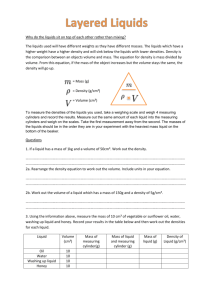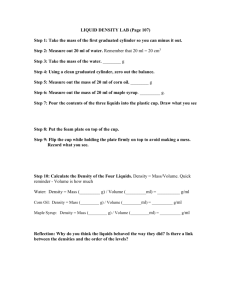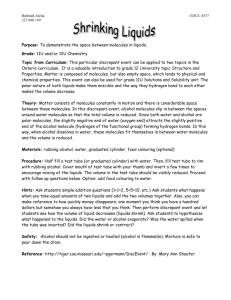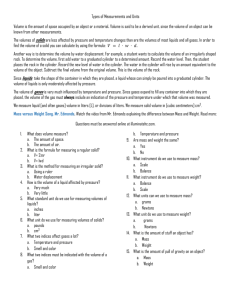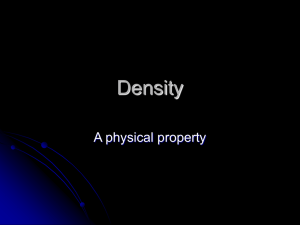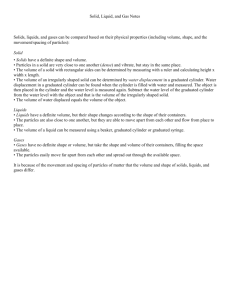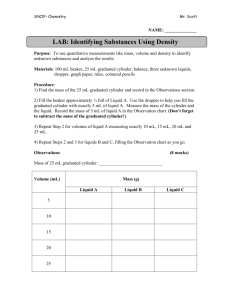Shrinking Liquids - Discrepant Event
advertisement
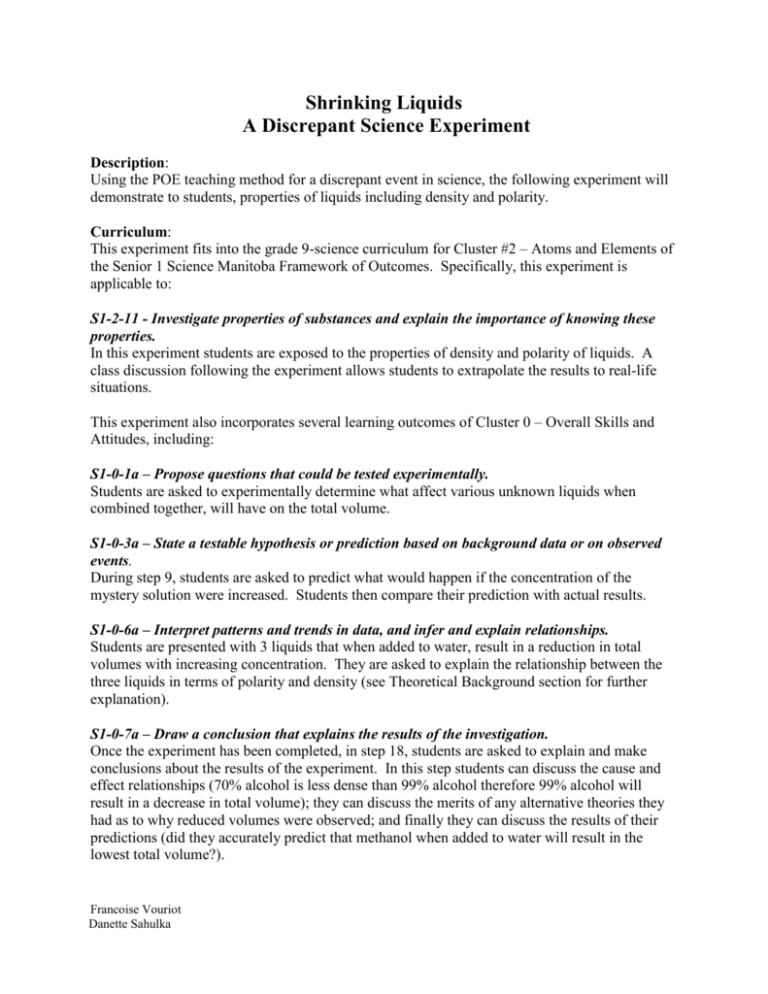
Shrinking Liquids A Discrepant Science Experiment Description: Using the POE teaching method for a discrepant event in science, the following experiment will demonstrate to students, properties of liquids including density and polarity. Curriculum: This experiment fits into the grade 9-science curriculum for Cluster #2 – Atoms and Elements of the Senior 1 Science Manitoba Framework of Outcomes. Specifically, this experiment is applicable to: S1-2-11 - Investigate properties of substances and explain the importance of knowing these properties. In this experiment students are exposed to the properties of density and polarity of liquids. A class discussion following the experiment allows students to extrapolate the results to real-life situations. This experiment also incorporates several learning outcomes of Cluster 0 – Overall Skills and Attitudes, including: S1-0-1a – Propose questions that could be tested experimentally. Students are asked to experimentally determine what affect various unknown liquids when combined together, will have on the total volume. S1-0-3a – State a testable hypothesis or prediction based on background data or on observed events. During step 9, students are asked to predict what would happen if the concentration of the mystery solution were increased. Students then compare their prediction with actual results. S1-0-6a – Interpret patterns and trends in data, and infer and explain relationships. Students are presented with 3 liquids that when added to water, result in a reduction in total volumes with increasing concentration. They are asked to explain the relationship between the three liquids in terms of polarity and density (see Theoretical Background section for further explanation). S1-0-7a – Draw a conclusion that explains the results of the investigation. Once the experiment has been completed, in step 18, students are asked to explain and make conclusions about the results of the experiment. In this step students can discuss the cause and effect relationships (70% alcohol is less dense than 99% alcohol therefore 99% alcohol will result in a decrease in total volume); they can discuss the merits of any alternative theories they had as to why reduced volumes were observed; and finally they can discuss the results of their predictions (did they accurately predict that methanol when added to water will result in the lowest total volume?). Francoise Vouriot Danette Sahulka In addition, the experiment can be used to describe miscibility and polarity in the Senior 3 Chemistry 30S fourth unit on Solubility. Materials: If the teacher is demonstrating this experiment you will need: 10 x 100mL graduated cylinders, labeled 1-10 Water – at least 300 mL 50mL each of: 70% isopropyl alcohol 99% isopropyl alcohol Methyl alcohol (methanol) Cooking oil Safety goggles Surgical or vinyl gloves MSDS sheets for the alcohols Note: If students are to complete this experiment in small groups, you will have to increase the materials required appropriately. Safety Precautions: Wear safety glasses and gloves, especially for handling the methanol. The alcohols used in this experiment may be toxic if ingested orally. Make sure students are aware of this fact and that the material at the end of the experiment is properly disposed of. Alcohol is extremely flammable! Make sure there are no open flames in the classroom during this experiment. Procedure: 1. Ask the class to make a chart for recording observations and predictions (you could also draw one on the chalkboard). The chart should look something like this: Cylinder # Cylinder # predicted final volume observed final volume The first cylinder # indicates the cylinder to which fluid will be added. The second cylinder # indicates the cylinder whose contents will be added to the first. 2. Measure 50 mL of water in two graduated cylinders (cylinders 1 and 2). Ask a student to verify the volume in both cylinders. 3. Ask students to predict what the final volume would be if cylinder 2 were added to cylinder 1 and to record it on their charts. 4. Add the contents of cylinder 2 to cylinder 1. 5. Ask a student to read the final volume and announce it to the class. Students may record the volume in the final column of their charts. Francoise Vouriot Danette Sahulka 6. Measure 50 mL of 70 % isopropyl alcohol in cylinder 4. Indicate to the students that this clear fluid is not water. Measure 50 mL of water into cylinder 3. 7. Repeat steps 3 – 5 for this couple of cylinders. The final volume will be lower than expected (i.e. below 100mL). 8. Ask the students to come up with some possible solutions. Do not provide an answer at this point. (You may have to indicate to students that traces of liquid inside cylinder #4 would not account for the observed loss in volume). 9. Ask the students to predict what would happen if the concentration of the mystery solution were increased. Indicate that the first solution was a 70% solution. What would happen with a 99% solution? 10. Measure 50 mL of 99% isopropyl alcohol into cylinder 6 and 50mL of water into cylinder 5. 11. Repeat steps 3 - 5 for this couple of cylinders. The final volume will be below 100mL and below the volume seen after step 7. 12. Tell the students that the mystery liquid is isopropyl alcohol. Draw the chemical structure of isopropyl alcohol on the board. Ask the students what would happen to the final volume if a smaller (smaller molecule) alcohol were added to water. Draw and name methanol on the board. 13. Measure 50 mL of methanol into cylinder 8 and 50 mL of water into cylinder 7. 14. Repeat steps 3 – 5 for this couple of cylinders. The final volume will be the lowest observed to this point in the demonstration. 15. Indicate at this point that water, isopropyl alcohol and methanol are all polar substances. Ask the class what would happen to the final volume if a non-polar liquid like cooking oil were added to water. 16. Measure 50 mL of cooking oil into cylinder 10 and 50 mL of water into cylinder 9. (You can add some food coloring to the water to show students that when the two are added together, there is no mixing occurring between the oil and water). 17. Repeat steps 3 – 5 for this couple of cylinders. The final volume will be near 100 mL but the oil will appear to “compress” the water level. Students will observe that the oil “floats” on the surface of the water. 18. Ask the students what they believe is happening. Draw the water molecules and alcohol molecules on the board and show their interactions as an explanation. Discuss with students what is happening in this experiment (see Theoretical Background section) and then have them extrapolate their findings to real life situations (see How This Event Creates Discrepancy for Students section). Francoise Vouriot Danette Sahulka Note: The students themselves in small groups could also do this experiment. Each group of 4-5 students would be given containers of the unknown substances that could be labeled as substances A through E. The students would then be asked to carry out the experiment as listed above in steps 1-17, making sure to fill out their charts. Once all groups had completed the experiment, a class discussion could ensue to explain the results. Theoretical Background: Both water and alcohol are polar liquids. This means that both liquids contain molecules that are overall neutral but have slightly charged ends, one negative and one positive. This is the result of unequal sharing of electrons in the covalent bond causing the negatively charged electrons to be slightly polarized. The electrons of water remain closer to the oxygen atom most of the time as compared to the space near the hydrogen atoms. This creates a negative pole near the oxygen and a positive pole near the hydrogens. http://percival.merlin.mb.ca:8901/SCRIPT/s3_chemistry30s_preview/scripts/serve_home There is also much space between molecules in matter. When two types of molecules are polar, the molecules of one liquid can slip between the molecules of the other and form hydrogen bonds between them due to electrostatic attraction of the poles of their molecules. When the molecules of isopropyl alcohol or methanol slip between the water molecules, the volume decreases as the molecules in the mixed liquid become more compacted. + Water molecule Hydrogen bond _ + Isopropyl alcohol _ + Water molecule _ + Isopropyl alcohol _ The density of water is 1g/mL while the density of isopropyl alcohol is 0.785 g/mL and the density of methanol is 0.792 g/mL. When the molecules of alcohol become more densely packed within the water molecules, the density of the mixture changes according to the formula density = mass/volume. If the volume decreases (and we know that mass is conserved), the density increases. Francoise Vouriot Danette Sahulka Cooking oil is non-polar in nature and is less dense than water. When added to water, due to its hydrophobic nature, the oil will float on top of the water and appear to “compress” the water level. When added together the oil-water mixture should almost equal 100mL. How This Event Creates Discrepancy for Students: This experiment provides a simple means of presenting a discrepant event to students to get them thinking about some of the properties of liquids including density and polarity. This experiment employs the PEO (predict, observe, explain) teaching model in that students are asked to make predictions about total volumes when two liquids are added together and compare their predictions to observed results. We compared two different alcohols and one in two different concentrations. The results show that the total volumes decrease as the alcohol concentrations increase. To create further discrepancy, students are asked to predict what will happen if cooking oil (a non-polar substance) is added to water. This event creates discrepancy for the students because: 1. From past experiences, students will logically predict that when you add 50mL of one clear liquid + 50mL of another clear liquid you will get a 100mL total volume. However, when you add 50mL of alcohol to 50mL of water, the total volume doesn’t add up to 100mL, it is less, and the students don’t know why. 2. In their explanation of what happened to result in the “shrinking” of liquids, the students probably won’t have any prior knowledge of how the alcohol molecules are able to pack between the water molecules to create a decrease in total volume. 3. As well, they will probably not know that the sum of two liquids can be denser than each individual, especially compared to the oil demonstration. 4. With the oil demonstration, students see the oil as being more viscous and therefore assume that the oil is denser. Those students that have never seen oil added to water may predict that the water will float on the oil. However, the oil is actually less dense compared to the water and therefore the oil floats on the surface of the water. Francoise Vouriot Danette Sahulka The importance of understanding the physical properties of liquids can be further stressed to students by using the results of this experiment to explain real life events. For example, you could initiate a class discussion whereby you ask students how the properties of polarity and density observed with the water-alcohol part of the experiment come in to play in real life. An example that could be discussed is that of gas line anti-freeze for automobiles. Everyone living in Manitoba during the winter will probably at some point in their lives use gas line anti-freeze in their vehicle. Water molecules that are in your gas tank, move through your gas line with the gasoline. As the temperature drops, the water freezes in your vehicle’s gas line thereby blocking passage of gasoline from the gas tank to the engine. Gas line anti-freeze acts in a manner similar to that observed with the alcohol and water in this experiment. The alcohol molecules in the anti-freeze mix and pack more closely with water molecules thus resulting in a lowering of the freezing point at which water will freeze in your vehicle’s gas line. With the cooking oil part of the experiment, students can be encouraged to extend their thinking to how the results in this experiment explain what happens in crude oil spills in the ocean. Students should now understand that due to the non-polar and lower density properties of oil compared to water, that the oil does not mix with water, but rather that it will float. This makes cleanup of oceanic crude oil spills much easier than if the oil mixed with water and had to be separated out from the water in some manner. Overall, the Shrinking Liquids discrepant event experiment is a fun and interesting way to help students understand the concepts of density and polarity of liquids. This is a great experiment to use in the classroom as it encompasses several of the Senior 1 Science learning outcomes and it is simple to set up and uses materials that are easily attainable. Francoise Vouriot Danette Sahulka References: The discrepant event in this paper can be found at: Koballa, T.R. (n.d.). The Motivational Power of Science Discrepant Events. Retrieved January 15, 2005 from http://www.arches.uga.edu/~bcramond/home/DiscrepantEvents.htm Additional resources for this experiment can be found at: Ohio State University. (n.d.). Hydrophobic exclusion diagram. Retrieved January 23, 2005 from http://www.mansfield.ohio-state.edu/~sabedon/biol1015.htm#hydrophobic_exclusion http://percival.merlin.mb.ca:8901/SCRIPT/s3_chemistry30s_preview/scripts/serve_home http://percival.merlin.mb.ca:8901/SCRIPT/s1_science10f_preview/scripts/serve_home www.inchem.org/documents/pims/chemical Francoise Vouriot Danette Sahulka
